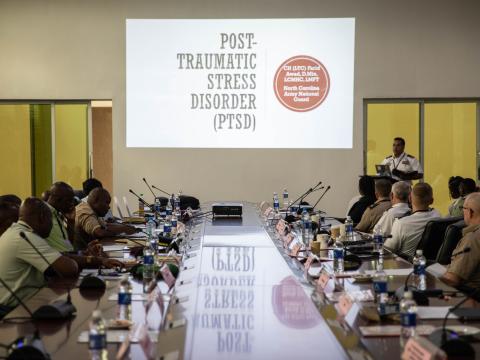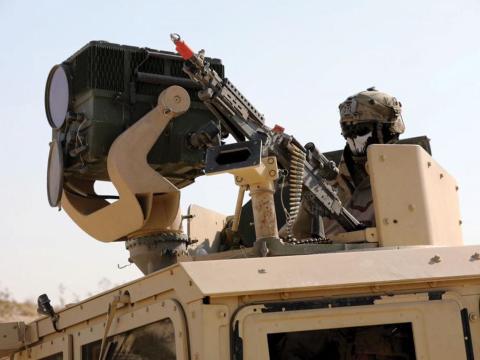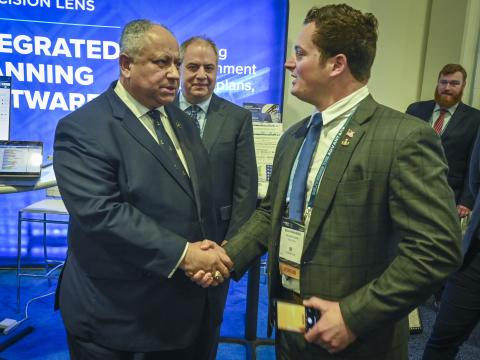Air Force Takes Aim at Lasers on Fighter Jets
For the Air Force, the daily use of a laser as a weapon itself is coming. The youngest of the U.S. military services, founded more than a decade before the laser’s invention, is looking to incorporate the high-energy systems into its warfighting arsenal.
Other military branches have recently developed or deployed these systems. The Navy installed a 30-kilowatt (kW) laser weapon system that operated on the USS Ponce for several years before its decommissioning on October 14, and the Army received a 60-kW combined fiber laser system in June from Lockheed Martin. This spring, the Army took over research and development of MAX POWER, counter-IED microwave technology that began as a concept within the Air Force Research Laboratory (AFRL) at Kirtland Air Force Base, New Mexico. Across the Atlantic, the U.K. Defence Science and Technical Laboratory unveiled its new laser cannon in September and will begin testing a demonstrator next year for Royal Navy applications.
The Air Force’s priority is to develop these technologies as well, according to the directed energy flight plan signed by Air Force Secretary Heather Wilson shortly after her confirmation in May. Given size, weight and power considerations, however, laser weapons in airborne applications are more complex than other types.
Still, the burgeoning military weapons offer an impressive list of capabilities. They engage targets at the speed of light, offer lethal and nonlethal applications, provide low probability of interception and detection, limit collateral damage, carry out covert attacks and deliver incredible surveillance. They are quiet, precise, responsive and have an endless magazine. “A laser’s ability is to see an aircraft or an object at a much, much greater distance than you can with normal electro-optics,” says Lt. Gen. Henry A. (“Trey”) Obering, USAF (Ret.), executive vice president, Directed Energy, Booz Allen Hamilton. “And then the capability to just turn the power up on the laser and disarm or destroy targets—think about those capabilities. That is a great weapon to have in your toolbox.”
Another huge benefit of laser weapons: cost per shot. “It is very cheap compared to what we are doing today,” emphasizes Obering, who aided in deploying elements of the first U.S. missile defense system. “It’s expensive for us to fire multiple million-dollar interceptor missiles and shorter- and intermediate-range missiles. But with a laser, you have very low cost per shot, and you are able to take out missiles in a matter of seconds. And with rechargeable lasers and redundant lasers, you can basically have an unlimited magazine. It is really imperative that we get these directed energy weapons out into the hands of the warfighters.”
The push now for the Air Force is to develop directed energy weapons with “increased amounts of power out of decreased amounts of size, weight, volume and power-input requirements,” Obering clarifies.
To that end, the Air Force Special Operations Command (AFSOC), Hurlburt Field, Florida, will begin incrementally evaluating a complete laser system—laser, beam control system, beam director, power supply and cooling, systems integration and casing—aboard its powerhouse striker, the AC-130J Ghostrider gunship, in the next fiscal year. The initial phase of testing will involve a turreted, solid-state electric laser set in place of the aircraft’s traditional 30 mm gun, located slightly in front of the wings and engines. The Naval Surface Warfare Center, Dahlgren Division, will receive a government-owned 4-kW laser from the Navy on behalf of U.S. Special Operations Command (SOCOM) and AFSOC, allowing AFSOC to retrofit the laser system components, used in an earlier Office of Naval Research effort.
“We think that the technology is mature to the point that it is ready to incorporate on an aircraft,” says Bill Lane, chief, Strike & Intelligence, Surveillance and Reconnaissance Requirements Division, AFSOC. “We are optimistic about phase one. We don’t see any large technology challenges there, and we believe it is going to lead to an operational laser on gunships.”
Initial testing will demonstrate all working parts of the laser system integrated at a much lower power setting than AFSOC envisions for the full 60-kW prototype, says Rhys Macbeth, AFSOC program analyst, AC-130 Gunship Requirements.
The command has been a strong proponent of laser weapons, particularly for offensive needs, as its mission is close air support and air interdiction. “It’s a natural fit in the evolution of our weapons systems,” Macbeth says.
However, to determine what kind of laser to test, “Dahlgren basically did a study for us on what the best implementation on a gunship would be,” Lane recounts. “The Navy has kind of the lead in this area, and we are following the results of that study.”
The first phase of testing should take about 18 to 24 months and be completed by the end of fiscal year 2019, “if funding holds,” Lane says. The second phase would involve an operationally representative demonstration of a 60-kW or larger laser prototype, with testing through fiscal 2022. A prototype has not yet been procured.
Using a government-owned system for the initial testing will reduce costs, Lane offers. “It will also work well in demonstrating the objectives of the first phase, which are to focus on mitigation of optical and mechanical jitter due to airflow around an airborne platform and vibrations of the platform,” he says.
The AC-130J gunship is an ideal platform for the laser, given its dual striker and cargo characteristics. “We believe it’s a good candidate,” Lane says. “There is significant available electrical power and space in the aircraft, and the gunship’s ability to carry the weight of a fairly large high-energy laser system makes it fairly easy to integrate.”
The laser weapon also presents few operational challenges, Lane says. Combat systems officers who already operate infrared sensors would operate the laser. Having these officers involved in testing the laser will be critical.
“Putting the laser system in the hands of operators will show how they can best employ it,” says AFSOC Acquisition Program Manager Dan Baradon. “They are the only ones that can assess and move that forward.”
Furthermore, the prototype may prove to be not the right fit for the final operational system. Source selection after the demonstration will dictate the system components for the AC-130J gunship.
About 10 years ago, the Advanced Concept Technology Demonstration of the Advanced Tactical Laser—the chemical oxygen iodine laser developed with Boeing—on a C-130H aircraft revealed the potential power of that laser but also great risks and size constraints. “The unfortunate part of that was that it took up the whole back end of the C-130,” Macbeth says. “Operationally, it was not a good fit.”
Accordingly, research at the AFRL has turned away from chemical-based lasers. “All of our device work at this point is now in electric lasers,” says Matthew Fetrow, tech engagement lead at AFRL New Mexico. “Electric lasers provide tremendous advantages over the chemical lasers we used to develop in the past.”
Development of the electric laser fits into the long view taken by the Air Force to place the weapon aboard fighter jets, but this will be “much more of a challenge,” Fetrow says, given stricter size, weight and power considerations. As such, the AFRL is working on demonstrating an electric laser placed in a pod on fighter jets through the Self-Protect High-Energy Laser Demonstrator (SHiELD) program. To be effective and to defend fighters from incoming air-to-air missiles, the laser must be a powerful system, Fetrow says. “Of course, we can build a system like this in a laboratory or in a large hanger. The challenge is getting it in a pod of a certain size. And the laser actually is the smallest part of it. The beam controller, the power control systems, the batteries required, the pointing control systems—that all needs to fit in the pod. That’s our true challenge,” he notes.
Booz Allen Hamilton will assist the AFRL’s SHiELD objectives of acquiring, tracking, aiming and firing a high-energy laser on a tactical aircraft flying at transonic and supersonic speeds over the next four years, Obering clarifies. Testing will begin in 2019 with a 50-kW laser and continue with a 150-kW laser between 2021 and 2025. Initially, Booz Allen Hamilton anticipates integration of SHiELD-type capabilities into older fighter jets, which would allow “the Air Force to move aircraft survivability to the lower left of the cost curve,” Obering says. In addition, Booz Allen is looking into the intersection of directed energy with electronic warfare and cyber for the SHiELD program. “We’ll be looking at these interactions, which can be very, very powerful and important for the future,” Obering emphasizes.
Notably, airborne laser weapons will not be able to operate on fighter jets—or even gunships—without technology that addresses turbulence. “It is a key, critical technology that is absolutely needed in order to be able to fire the laser practically in any direction around the aircraft and not be hindered by the turbulent effects of the airflow in and around the laser turret,” says Bob Ruszkowski, director, Advanced Air Dominance and Unmanned Strike Systems, Lockheed Martin Skunk Works, Lockheed’s secretive special projects office.
Working with the Air Force and the Defense Advanced Research Projects Agency (DARPA), this division of Lockheed Martin has labored for the last six years to develop Aero-adaptive Aero-optic Beam Control, and the company says the technology is ready. “We are at technology readiness six or greater for use of the Aero-adaptive beam control technology at subsonic speeds,” Ruszkowski reports. More work needs to be done to extend the technology into supersonic speeds.
Lockheed Martin also will focus on assisting AFSOC in the demonstration of the total laser weapon system on the gunship over the next several years. “It will be the first time we actually get to integrate a complete electric laser weapon system with the C-130,” Ruszkowski says. “We certainly believe that all the components of a laser weapon system—whether it is the laser source, the beam control, the Aero-adaptive technology—are mature enough now and are at a tipping point. We believe we are able to integrate them on a platform like an AC-130 and provide warfighting capability.”
But one challenge that persists for the Air Force is funding. “Laser weapons have been right around the corner forever,” Obering says. “Ten years ago, we were funding-rich and technology poor. Now that the state-of-the-art technologies are being developed, we are technology rich and funding limited. Many, many energy weapon programs across [the Defense Department], if they had even a modest increase of funding, would be able to move ahead much more rapidly and mature.
“This is a capability that this country needs,” he insists. “It’s imperative that Congress step up and fund all of the laser programs in the way that they should be funded. We really need these capabilities as we move into an increasingly dangerous future.”






